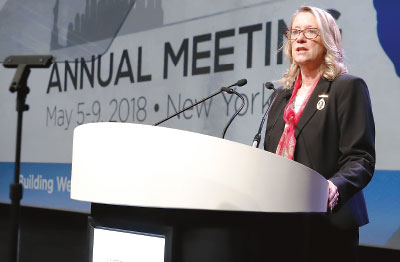Everett Sums Up State of Psychiatry in America and Where Profession Is Headed
Abstract
One of the keys to psychiatry’s future is the development of innovative technologies that will reduce administrative burdens and improve patient care.
Psychiatry is strong and growing and in demand, said APA President Anita Everett, M.D., at the Opening Session of APA’s 2018 Annual Meeting last month in New York City. In a packed auditorium of APA members and other attendees, she recalled a busy presidential year focused around her career-long dedication to public psychiatry and a determination to help psychiatry position itself for the future.

APA President Anita Everett, M.D., tells attendees at the Opening Session of APA’s 2018 Annual Meeting last month that there was a 5.2 percent increase in the number of PGY-1 psychiatry slots between 2010 and 2015, and the number of residents entering psychiatry has been steadily increasing. “This is positive news as we look into the future,” she said.
“Throughout my year, I have appointed community and public-sector psychiatrists to everything I could in hopes that this would increase exposure and experience with our part of psychiatry—community psychiatry.”
She noted that she appointed a work group chaired by New York City public psychiatrist Paula Panzer, M.D., specifically devoted to strategic planning around APA’s fall conference, IPS: The Mental Health Services Conference. “We hope that as more of our members become interested in working in public and community psychiatry, and as working conditions for those jobs become better, the fall meeting will be more widely attended,” Everett said.
Everett outlined the efforts of three other work groups she appointed around her priority interests: physician well-being and burnout, innovation and technology, and smart prescribing.
The Work Group on Physician Wellness and Burnout, chaired by Richard Summers, M.D., has produced in a short time a range of tools and resources available on the APA website.
“The next time you have an unexpected no-show, visit our website at psychiatry.org/wellbeing and browse through some of the materials that are posted there,” she said. “Take the Oldenburg Burnout Scale anonymously and see where you fall in terms of burnout. The first reveal of this tool was at the fall 2017 meeting of the Assembly where we had about 400 members take the survey. To date, we have had nearly 1,500 participants take the survey. And what have we learned about our members? We have learned that well over half of us show signs of burnout as measured by this tool. We have learned that there is a correlation between burnout and gender, with female physicians being at higher risk for burnout compared with their male counterparts. We have also found that burnout really affects our younger members, many of whom are just starting their careers. We’ve found that a lack of control over one’s work schedule also correlates with higher rates of burnout.”
Everett urged members to read the year-long series of member-written articles on burnout in Psychiatric News and a related regular column devoted to what inspired people to become psychiatrists.
“The series was intended to inspire all of us to think about the big picture and social value of our profession,” she said. “We all aspired to something when we chose to pursue psychiatry: advance neuroscience, help people, ease pain, heal families, and improve communities. A number of our members wrote compelling pieces for that series, and I hope that they may have had positive impact on our members.”
Closely related to the issue of professional well-being is the ability of psychiatrists to adapt to—and take advantage of—the digital revolution. The Work Group on Access Through Innovation and Technology, chaired by John Santopietro, M.D., and co-chaired by John Torous, M.D., presented an ambitious report to the Board of Trustees in April that outlined recommendations in two key areas: emerging business models for delivering mental health care and digital medicine and health information technology. The Board of Trustees voted to accept the report and referred its recommendations to the Joint Reference Committee and the APA administration for a report in July on how to implement them.
“Most of us are familiar with telepsychiatry, which usually provides diagnosis and treatment through scheduled appointments,” Everett said. “But could one do psychotherapy on demand? Could asynchronous telemedicine be effective? What about apps for well-being and outreach? There are already very established practices that provide on-demand emergency room telemedicine with psychiatry.
“A part of the future of our profession depends on our ability to work with innovation so that it augments what we do and is built upon evidence regarding outcomes for patients and not profit margins,” she said.
Finally, a work group on “smart prescribing,” chaired by past APA President John Oldham, M.D., will continue to work through the term of incoming APA President Altha Stewart, M.D. “This work group has made recommendations to the Board regarding an overall strategy for APA in addressing the safe prescribing of medication and psychiatric medication and scope of practice by professionals who do not have extensive biologically based medical training,” Everett said.
Throughout her address, Everett expressed a deep commitment to psychiatry in the public sector. “I am here to tell you that working in community psychiatry settings can be fun, enriching, and rewarding,” Everett said. “We need good psychiatrists to work as systems designers and leaders in these settings, and we don’t want to abdicate this important function to other providers.” ■



